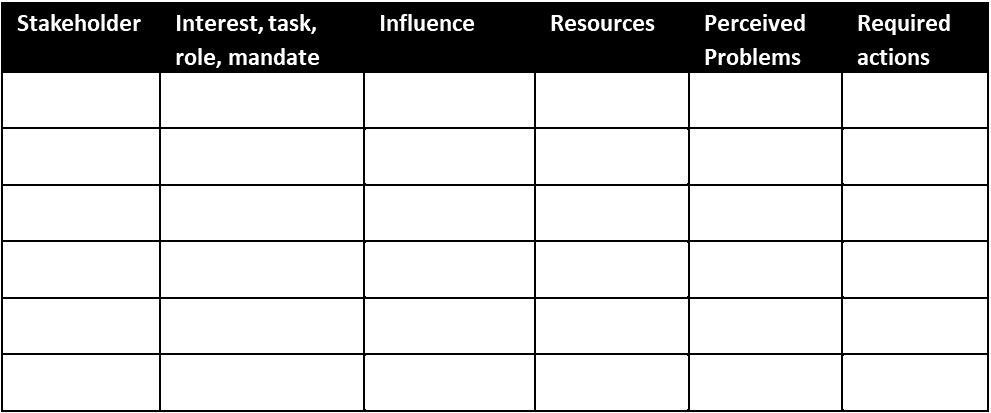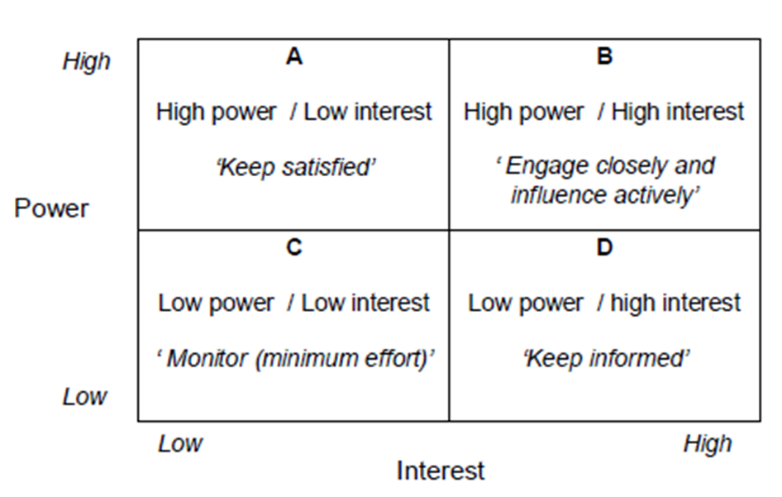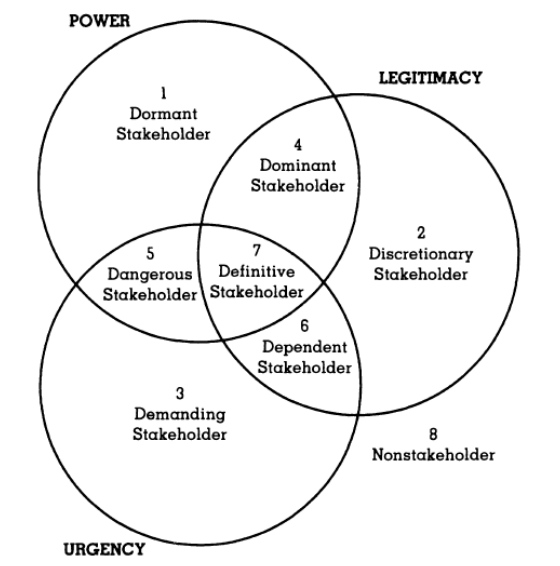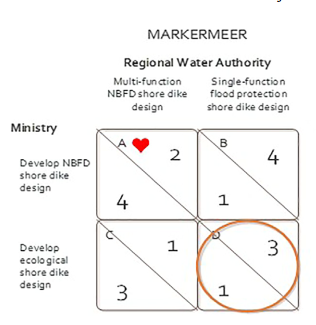Guidance: stakeholder analysis
Being multi-functional and context-based, Building with Nature (BwN) implies different and more stakeholder-involvement during all stages of the project cycle, including initiation design, construction, management, maintenance and monitoring. BwN is closely connected to the local context of application, making the involvement of (local) stakeholders critical for the successful implementation of BwN measures. To achieve this, a multi-stakeholder approach is required. Stakeholder analysis has proven to be a very effective methodological process for thoroughly understanding the stakeholder context and lays the foundation of the participatory process of this multi-stakeholder approach.
What is stakeholder analysis?
Stakeholder analysis is a systematic way to identify and analyze stakeholders and their interests. The analysis provides insights into stakeholder dynamics and helps to identify those stakeholders that are crucial for successful implementation.
Stakeholders are defined as ‘any group or individual who can actively affect or who is affected by the project development’ (Freeman, 1984). As such, stakeholders can be anything from individuals affected by a project to large-scale non-governmental institutions whose organizational goals are related to certain aspects of the project.
Stakeholder analysis is a process that should start in the initial phase of a BwN project, since it provides the foundation for decisions on stakeholder involvement and cooperation. Both these processes require time in order to build trust, which is essential for cooperation and obtaining support in later phases of a project. In addition, it is beneficial to a project’s success to incorporate stakeholder knowledge at an early stage. As a project evolves, new stakeholders may emerge, and others may change their positions making the analysis a continuous process in the project development.
Stakeholder analysis generally involves roughly four activities, namely – identification, – assessment, -categorization and stakeholder interaction modelling. While these activities can be filled out in an analytical manner, for example using a desk study, it can be very valuable to include stakeholders. For example by organising workshops or alternatively have stakeholder check the outcomes.
Stakeholder identification
The first activity in a stakeholder analysis is the identification. Information on stakeholders can be gathered through structured brainstorming sessions and interviews in combination with literature studies. The result of this first step of the analysis is a list of stakeholders. In addition to brainstorm sessions, other tools for stakeholder identification are ‘rich picture’ and ‘snowballing’.
Rich Picture: A rich picture is a drawing of the local context and situation. The drawing should depict the main components (including stakeholders) of a situation. This alternative method can be used in groups and is often perceived to be an easy way to discuss complex and perhaps sensitive situations. The method was developed by Checkland and Scholes (1990).
Snowballing / Social Network Analysis: Social Network Analysis is a process in which stakeholders are identified based on a snowballing method. In this process an initial stakeholder is approached and asked to provide a list of all their relevant contacts. Subsequently, all stakeholders whose names were provided by this first stakeholder will be approached and asked to list their contacts and so on and so forth. The result not only consists of a list of identified stakeholders, but also shows the interaction and links between the various stakeholders. These results can be used to construct a Social Network that consists of nodes which are connected by edges. Nodes may symbolize individual people, organizations or other stakeholders. The links between nodes, or edges, indicate a relationship or interaction. Social Network Analysis is especially relevant in a context where informal networks and structures are presiding.
Stakeholder assessment
Once stakeholders are identified, it is important to highlight and describe their interest, task, roles, and mandate (in relation to the project), influence (what influence and on which), resources (which resources and how can they be used), perceived problems (by the stakeholder) and required actions (according to the stakeholder). This overview can be easily structured in a stakeholder table and often uses interviews, surveys and documents for data gathering. This overview provides highlights that might be crucial due to their role and mandate within the given context. The results will be used as the basis for further analysis as part of the categorization and ranking in the next step of the stakeholder analysis.

Hermans et al. (2018) introduce the objectives-interest table (table 2), which is suitable for situations with a clear problem that requires a solution. A distinction is made between strategic objectives related to the general context, and problem specific objectives, which are connected to the problem situation. When combined these two elements indicate the level of interest that a stakeholder has in the specific situation and context.

Stakeholder categorization
Not all stakeholders are equally interested or committed to a project and its outcomes. In addition, not all stakeholders have the same level of interest or ability to influence a project. This third activity aims to build upon the results of step 2 and categorizes stakeholders in order to make more effective decisions in stakeholder management and engagement. Moreover, it should identify stakeholders that are crucial to the BwN project and provide insights that can be used to foster cooperation among them.
A commonly used method for this is the Power-Interest matrix (Ackerman and Eden, 2011). This matrix groups stakeholders based on their interest and power. Interest refers to the stake of a group or organization regarding a specific issue. The concept of power refers to the ability to influence final project outcomes and the development process. Stakeholders can be assigned a high, medium or low score for each of these concepts. The overview supports identification of which stakeholders to involve in a BwN project and how. The final outcomes of the Matrix classify the stakeholders into the following four groups:

- Context Setters ‘A’: These are stakeholders with high power but low interest. Their power provides part of the context in which a development is pursued. Spend enough effort to keep them satisfied, but not so much that it becomes counterproductive. When possible, try to increase their level of interest.
- Key Players ‘B’: These are stakeholders with high power and high interest. This can relate to the actor’s own interest, as well as the project developer’s interest in what the actor can add to the project in terms of relevant knowledge, perspectives and resources. These are the people to fully and intensively engage in the processes and to focus the most effort on. It is important to keep them actively involved in project development and consulted regularly.
- Crowd ‘C’: These are stakeholders with low power and low interest. This group can be monitored and informed passively. Do not bother them with excessive communication. When possible, try to increase their level of interest.
- Subjects ‘D’: These are stakeholders with low power but high stakes. Make sure to adequately inform them and to avoid major problems. Often these people can be helpful with the details of the project. While Ackerman and Eden (2011) suggest to keep this group ‘informed’, from the perspective of including less powerfull groups and ‘social inclusiveness’ this may not be preferable. The ‘salience model’ (see below) recommends differently.
Other tools for stakeholder categorization include the Basic Stakeholder Analysis Technique and the Salience Model.
The Basic Stakeholder Analysis Technique (Bryson, 1995) is often referred to as the ‘traffic light approach’. A stakeholder’s interests are color-coded based on the degree in which they are in line with the objectives of a project and final outcomes. Red refers to a poor overlap in the interests of a stakeholder and project goals from a stakeholder’s point of view, yellow indicates poor similarity and green represents a strong overlap in objectives.
The Salience Model is developed by Mitchell et al. (1997) who argue that power is not necessarily the most important attribute. The model classifies stakeholders according to three indicators: Power, Legitimacy and Urgency. The final output is organized as a Venn Diagram with 8 different zones (see figure below).

Understanding stakeholder interactions
A range of models is available to study interactions of actor through models. Actor interaction models help understanding the behavior of actors in processes, such as implementation of building with nature trajectories. An informative book on actor models with practical applications is published by Hermans et al. (2018).
In the field of Building with Nature, game theory is a modelling tool that can be used to provide information in strategic situations and helps to understand the interactions of different players in decision-making. Game theory is concerned with “the actions of decision-makers who are conscious that their actions affect each other” (Rasmusen 2007, p.11) and involves describing and solving games by means of a “logical analysis of situations of conflict and cooperation” (Straffin 1993, p.3). Because Building with Nature always requires cooperation among players, understanding their interactions is essential. Janssen et al. (2020) used game theory to model stakeholder interactions, or games, in nature-based flood defence implementation. Their simulations revealed that social dilemma’s inhibit the implementation and uptake of natural solutions: “while a multi-functional nature-based solution is attractive to a coalition of actors, it is not the most beneficial option for individual actors”. This information can be used to assess the feasibility of BwN and may affect the adjustment of strategies to enable BwN.

